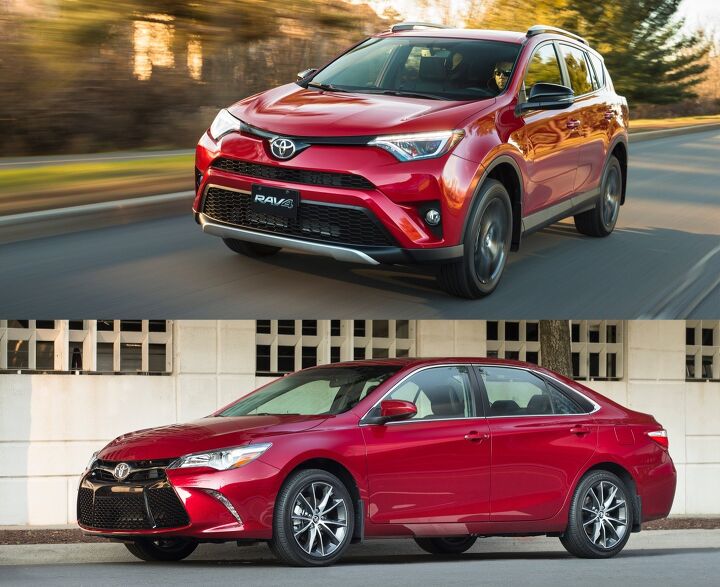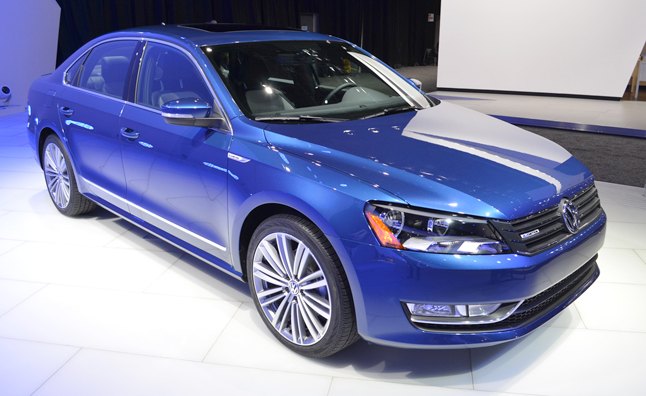#MidsizeSedans
It Didn't Take Five Years: The Toyota RAV4 Outsold The Toyota Camry In August 2016
Will the Toyota RAV4 outsell Toyota’s long-running best-selling car, the Toyota Camry, within the next five years? Nine months ago, Toyota Motor Corp.’s U.S. boss, Bob Carter, said, “I’ll bet you lunch that will happen.”
It didn’t take five years.
To be fair, Carter wasn’t referring to a single month’s results. Indeed, through the first two-thirds of 2016, the Camry produced nearly 36,000 more U.S. sales — about one month’s worth — than the RAV4.
But in August 2016, for the first time in Toyota’s U.S. history, the Toyota RAV4 was more popular than the Toyota Camry. And the RAV4 was by no means the only vehicle to outsell the most popular car in America.
It's Not Easy Being #1: Camry Incentives Rise High as Toyota Chases 15th Consecutive Year on Top
The Toyota Camry began a streak of 14 consecutive years as America’s best-selling car in 2002. Holding that number one position isn’t easy.
Toyota does not merely need the Camry to continue to live up to its reputation for reliability, and subsequently incite demand. Toyota also requires massive production capacity and a pricing scheme that matches production capacity to demand.
Demand in the United States for conventional midsize cars, however, is falling quickly. Year-to-date, overall midsize car volume is down 8 percent. In July 2016, midsize car sales fell 15 percent.
With a 2016 Camry now attempting to leave dealer lots as a five-year-old car, more than two years since its last refresh, Toyota’s desire for the Camry to maintain its high-volume nature and best-selling posture is now matched by a significant uptick in Camry incentives.
Toyota is now discounting Camrys 27-percent more than just one year ago, with an average incentive spend per Camry of $3,760 in July.
Would Most Crossover Drivers Be Happier With Sedans?
“Well, I mean, all this is basic and terrible,” said Mrs. Bark, pointing to the dash of our rental Hyundai Sonata. “But this could work for us.”
Mrs. Bark just turned 40. She’s an educated woman with four college degrees. She’s a college professor, almost the definition of a middle-class job. And yet she’s never owned the most middle class of vehicles — a mid-sized sedan.
When she became pregnant with our first child in 2007, she owned a 2005 Scion tC that we bought new from the dealership. After roughly a month of dealing with taking a baby seat in and out of the back seat of the little coupe, she decided that she needed something more suitable for motherhood. Since I owned an RX-8 then, I decided that we’d look at Mazda’s offerings, the Mazda5 and the CX-7.
Strangely enough, we never even considered a mid-sized sedan … but maybe we should have.
I'm Driving a 2016 Chevrolet Malibu 1.5T and Feel Guilty for Liking It This Much
We were in our Honda Odyssey last Saturday, transporting our dog to a special canine event 20 miles from our home, when the gorgeous 2016 Mazda6 was taken from our house and a Chevrolet Malibu was backed into the driveway.
Not the ninth-generation Malibu, a car which drew my ire in a TTAC review last spring. This is the all-new 2016 Chevrolet Malibu, a follow-up to the abbreviated ninth-gen car that chronically underperformed despite GM’s swift (and insufficient) response to early critiques.
Surely I’m no different from many of you. I’m predisposed to disliking Malibus, not because of inexplicable inner bias or a distaste for the Bowtie or a fondness for Honda Accords, but because the Malibu has spent much of the last two decades sucking. The eighth-generation car, which GM sold from 2008 to 2012, was an exception, but its two immediate predecessors were sad examples of the midsize breed. The 2013-2015 Malibu was a step backwards. As a result, the Malibu name conjures up memories of wooden dynamics, harsh interiors, strange noises, and pitiful styling.
Yet with each passing day of its stay at GCBC Towers, I’m steadily finding more and more things to like about the new 2016 Chevrolet Malibu.
What’s happening to me?
2016 Chrysler 200 Limited Rental Review - An Appreciation Of An Extraordinary Automobile
A few months ago, my esteemed colleague Ronnie Schreiber found himself in possession of a McLaren 675LT for the week. Not having a tremendous amount of personal experience with supercars, and not in a position to kill $10,000 worth of consumables in a single day at Thunderhill, Ronnie decided not to write a conventional review of the 675LT. Instead, he wrote an “Appreciation” of the Macca, eschewing the world-weary, seen-it-all shtick of the print-rag supercar review for an honest description of what it’s like to be a regular fellow who just happens to be holding the keys to something truly outrageous. Check it out, if you haven’t already read it.
Last week, I had the occasion to put 515 miles on a rented close-to-base-model Chrysler 200 in about a ten-hour period. It’s safe to say that most of you don’t like Chrysler’s entry-luxury take on the Fiat Compact platform. As a matter of fact, the 200 is currently a strong contender for Mr. Stevenson’s reanimated TWAT awards.
I’d like to see if I can change your mind about that.
Compact SUVs Gain Popularity At Expense Of Midsize, Compact Cars
While compact SUVs are doing well in the showroom, their success comes at the expense of midsize and compact car sales.
Volkswagen Unveils Plans For 5 Series/E-Class Fighter
The world is not enough for Volkswagen AG, as it now has plans to introduce a mid-size sedan to slot between the Passat and the Phaeton.
Chrysler 200 Earns EPA Rating Of 18 MPG City, 29 MPG Highway
While Fiat Chrysler Automobiles has yet to announce fuel economy for the new 2015 Chrysler 200, the Environment Protection Agency inadvertently leaked figures for one configuration, the V6 AWD model.




















Recent Comments